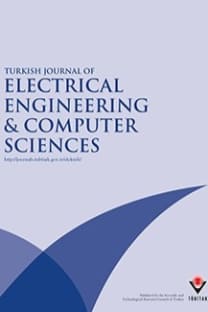Transient stability analysis of VSC HVDC transmission with power injection on the DC-link
Transient stability, voltage source converter, DC power injection
Transient stability analysis of VSC HVDC transmission with power injection on the DC-link
___
- transmission having DC power injection on the DC-transmission corridor was modeled in the time domain. The zero-input zero-state (ZIZS) response was used to find the solution of the state-space representation. The system was also modeled in the MATLAB/Simulink environment. The results show that the power injection created an additional damping of the postfault oscillations of the AC-side power angle and the DC-side voltage and power oscillations, hence enhancing transient stability.
- Jiuping P, Reynaldo N, Tang L, Holmberg P. VSC-HVDC control and application in meshed AC network. In: IEEE 2008 Power and Energy Society General Meeting; 20–24 July 2008; Pittsburgh, Pennsylvania, USA. New York, NY, USA: IEEE. pp. 1–6.
- Alok K, Amar K. HVDC LIGHT and FACTS technology: a modern approach to power system interconnections. Int J Eng Res Appl 2012; 2: 1331–1336.
- Hamzei-Nejad A, Ong C. Coordinating the DC power injections of a multiterminal HVDC system for dynamic control of line flows. IEEE T Power Syst 1986; 1: 142–152.
- Du C, Bollen M, Agneholm E, Sannino A. A new control strategy of a VSC-HVDC system for high quality supply of industrial plant. IEEE T Power Deliver 2007; 22: 2386–2394.
- Bianchi F, Junyent-Ferre A, Gomis B. Droop control design for multi-terminal VSC-HVDC grids based on LMI optimization. IEEE T Power Deliver 2011; 26: 2476–2485.
- Gang S, Guoxiang W, Xu C, Zhe C. Coordinated control of multi-terminal VSC-HVDC transmission for large offshore windfarm. In: IEEE 2012 Power Electronics and Motion Control Conference; 2–5 June 2012; Harbin, Heilongjiang, China. New York, NY, USA: IEEE. pp. 1278–1282.
- Ruihua S, Chao Z. VSC based HVDC and its control strategy. In: IEEE 2005 Power and Energy Society Transmission and Distribution Conference & Exhibition; 18–20 December 2005; Dalian, Liaoning, China. New York, NY, USA: IEEE. pp. 1–6.
- Callavik M, Bahrman M, Sandeberg P. Technology developments and plans to solve operational challenges facili- tating the HVDC Offshore Grid. In: IEEE 2012 Power and Energy Society General Meeting; 22–26 July 2012; San
- Diego, CA, USA. New York, NY, USA: IEEE. pp 1–6.
- Masters C. Voltage rise: the big issue when connecting embedded generation to long 11 kV overhead lines. Power Eng J 2002; 16: 5–12.
- Van Zyl S, Gaunt C. Generalised method for evaluating voltage rise in DG-equipped networks. In: CIGRE 2005 Distribution System and Dispersed Generation; 2005; Cape Town, South Africa.
- Nnachi AF, Munda JL, Nicolae DV, Mpanda Mabwe A. Power sensitivity and algebraic technique for evaluation of penetration level of photovoltaic on dc link of VSC HVDC transmission. In: IPEC 2012 10th International Power
- and Energy Conference; 12–14 December 2012; Ho Chi Minh City, Vietnam. New York, NY, USA: IEEE. pp. 121–126.
- Padiyar RK. FACTS: Controllers in Power Transmission and Distribution. 1st ed. Tunbridge Wells, UK: Anshan Publishers, 2009.
- Jiuping P, Nuqui, R, Srivastava, K, Jonsson, T, Holmberg, P, Hafner, YJ. AC grid with embedded VSC-HVDC for secure and efficient power delivery. In: IEEE 2008 Energy 2030 Conference; 17–18 November 2008; Atlanta, GA, USA. New York, NY, USA: IEEE. pp. 1–6.
- Chetty L, Ijumba N, Britten A. Parallel-cascaded tapping station. In: IEEE 2004 International Conference on Power System Technology; 21–24 November 2004. New York, NY, USA: IEEE. pp. 1874–1879.
- Rahman H, Khan B. Possibility of power tapping from composite ac-dc power transmission lines. IEEE T Power Deliver 2008; 23: 1464–1471.
- Nnachi AF, Munda JL, Nicolae DV, Mpanda Mabwe A. VSC HVDC transmission corridor: an option for PV power injection and AC network stability support. In: IEEE 2013 International Conference on Industrial Technology;
- –27 February 2013; Cape Town, South Africa. New York, NY, USA: IEEE. pp. 503–508.
- Yang J, Fletcher J, O’Reilly J. Multiterminal dc wind farm collection grid internal fault analysis and protection design. IEEE T Power Deliver 2010; 25: 2308–2318.
- Tang L, Ooi B. Protection of VSC-multi-terminal HVDC against DC Faults. In: IEEE 2002 Power Electronics Specialists Conference; 23–27 June 2002. New York, NY, USA: IEEE. pp. 719–724.
- Baran M, Mahajan N. Overcurrent protection on voltage-source-converter-based multiterminal DC distribution system. IEEE T Power Deliver 2007; 22: 406–412.
- Zhang L, Harnefors L, Rey P. Power system reliability and transfer capability improvement by VSC-HVDC (HVDC Light). In: CIGRE 2007 Conference on Security and Reliability of Electric Power Systems; 18–20 June 2007. Paris, France: CIGRE. pp. 1–7.
- Mousavi JM, Butler-Purry LK. A novel condition assessment system for underground distribution applications. IEEE T Power Syst 2009; 24: 115–1125.
- Rafferty J, Xu L, Morrow JD. DC fault analysis of VSC based multi-terminal HVDC systems. In: 10th IET 2012 International Conference on AC and DC Power Transmission; 4–5 December 2012; Birmingham, UK. London, UK: IET. pp. 1–6.
- Yang J, Fletcher JE, O’Reilly J. Multi-terminal DC wind farm collection grid internal fault analysis and protection design. IEEE T Power Deliver 2010; 25: 2308–2318.
- ISSN: 1300-0632
- Yayın Aralığı: Yılda 6 Sayı
- Yayıncı: TÜBİTAK
Hossein DELAVARIPOUR, Behzad Mirzaeian DEHKORDI
A novel control method for a VSC-HVDC system in a grid-connected wind farm
Energy economy in regulated and market-based power system: case study in Serbia
Mileta ZARKOVIC, İvan SKOKLJEV
Gangatharan SIVASANKAR, Velu Suresh KUMAR
Variable charge/discharge time-interval control strategy of BESS for wind power dispatch
Sara NOUROLLAH, Abolfazl PIRAYESH, Poria Hasanpor DIVSHALI
Performance evaluation of three phase SRF-PLL and MAF-SRF-PLL
Amorphous core transformers efficiency analysis in Turkish electrical distribution systems
Aleksandar JANJIC, Suzana SAVIC, Lazar VELIMIROVIC, Vesna NIKOLIC
